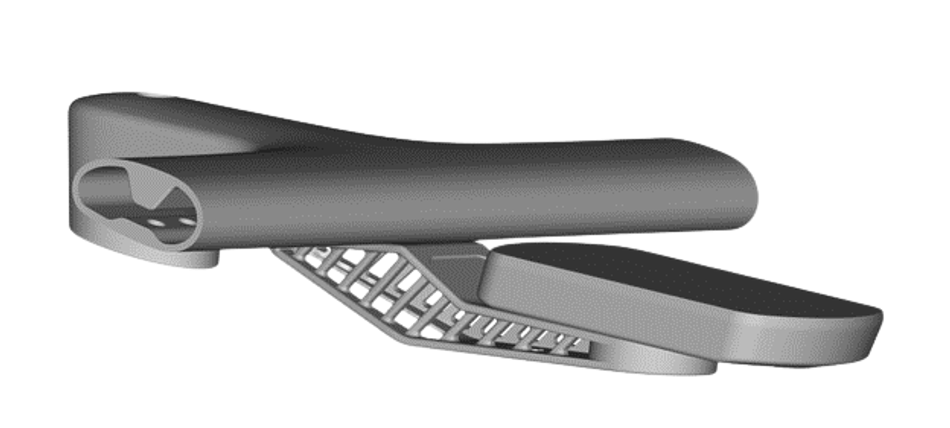Design optimized bike computer mount with 50 percent reduced weight and improved stability
To be able to fix the bike computer to the bike, a corresponding mount is necessary. The bike computer mounts currently available on the market are traditionally manufactured by injection molding – showing their limits when it comes to weight, functionality, design and manufacturing.

Canyon 3D printed computer mount (Source: Canyon)
Bike Computer Mount
For many cyclists, their bike is much more than a means of getting from A to B – it’s an integral element of their daily lives. The numerous benefits for the protection of our planet’s environment go without saying, positioning bikes as a cornerstone of future mobility, especially in urban areas. As a constant tour companion, bike computers allow not only hobby athletes, but also pros to plan, track, analyze, and share their routes and training in detail. GPS in combination with many other features supports them on their tour and allows for precise analysis of training data like measurements of speed, heart rate, or power in watts.
Project Breakdown
Industry
Consumer Goods
Material / Product
Ultrasint® PA11 Black CF, Ultrasim®
Why Forward AM?
Virtual Engineering expertise and perfect-fit material
The result
Design optimized bike computer mount with 50% reduced weight and improved stability
Challenge: Making the computer mount a light and reliable companion
To be able to fix the bike computer to the bike, a corresponding mount is necessary. The bike computer mounts currently available on the market are traditionally manufactured by injection molding – showing their limits when it comes to weight, functionality, design and manufacturing.
Striving for improved performance, Canyon, a market-leading bike manufacturer based in Koblenz, Germany, investigated ways how to optimize their computer mount. The requirements for the new mount were clear – being as light and as steady as possible to always ensure excellent readability of the bike computer during the ride. With regards to market availability, Canyon followed a two-fold approach – the mount is going to be launched coming with the latest model “Ultimate” from Canyon, but also to be sold to end customers separately.
Multiple reasons at once were in favor of Additive Manufacturing for the redesign and production of Canyon’s new computer mount: to be able to truly redesign the part from scratch, ‘thinking additive’ with dedicated digital simulation tools opens the unique possibilities of 3D printing, unattainable with any other technology. With regards to the production process, with the envisaged batch size of around 3,000 units, Additive Manufacturing is the perfectly suited manufacturing method. One specific aspect of the new design consists in the mount’s compatibility with the two main bike computer brands that require two different adapter boards. One key benefit of 3D printing is functional integration – by exploiting the full potential of design for Additive Manufacturing, we redesigned components to be much more functional, requiring fewer assembly parts resulting in reduced assembly time, and thus cost and weight. By taking this requirement into account during the design phase early on, the design of the new mount will be compatible with the two main bike computer brands without any separate production of different set-ups.
Solution: Virtual Engineering expertise coupled with lightweight material Ultrasint® PA11 Black CF
The most important requirement of the redesigned mount is to ensure excellent readability of the bike computer during the ride. No matter if driving on pavement, cobblestone, or forest soil offroad, the bike computer should always be clearly legible. To identify the optimal design, the analysis of the eigenfrequency is essential – the frequency at which a system tends to oscillate when not subjected to an external force. For clear visibility, the vibration should be as low as possible – thus, the eigenfrequency of the component has to exceed the external excitation. Forward AM’s Virtual Engineering experts performed simulative vibration analyses to evaluate different designs and materials with regards to that. Based on the findings, added by peak load analyses, a topology optimization was performed to achieve the optimal part performance.
In close cooperation between Canyon, our 3D printing service provider Sculpteo and Forward AM’s Virtual Engineering experts, the new design was finally developed, evaluated and decided. Focusing on the material, Forward AM’s polymer powder Ultrasint® PA11 Black CF was selected to bring the freshly designed part to life.

Combining high rigidity with optimized design for Additive Manufacturing the material is ideally suited for lightweight applications where performance matters. Carbon-fiber reinforcement makes it one of the strongest and most rigid materials in the industry, allowing printed components to deliver optimal mechanical performance when strength and rigidity are crucial. The polymer component of Ultrasint® PA11 Black CF is a bio-polymer derived from castor oil, which contributes to making applications more sustainable.
After being printed, the printed mount gets the finishing touches and a sealed surface by applying vapor smoothing technology – ensuring great aesthetics on the road.
Result: Functionally integrated bike computer mount – trusted performance at 50 percent reduced weight
 Canyon 3D printed computer mount (Source: Canyon)
Canyon 3D printed computer mount (Source: Canyon)

“Forward AM’s Virtual Engineering expertise and deep material knowledge enabled us to realize the lightest, fully functional computer mount in our portfolio. We exploited the full potential of 3D Printing to quickly iterate innovations and adapt the design of the mount to our exact needs.”
Christian Gundlach, Product Manager Gear, Canyon
By leveraging the benefits of Additive Manufacturing, Canyon created a new generation bike computer mount that is lightweight, durable and provides a new standard of excellence in maintaining reliable stability during the ride. In close cooperation, Forward AM and Canyon employed the full potential of 3D printing – Virtual Engineering combined with the precise material needed to realize the design – and harnessed the possibilities of 3D printing to the fullest resulting in one of the lightest bike computer mounts available on the market.



